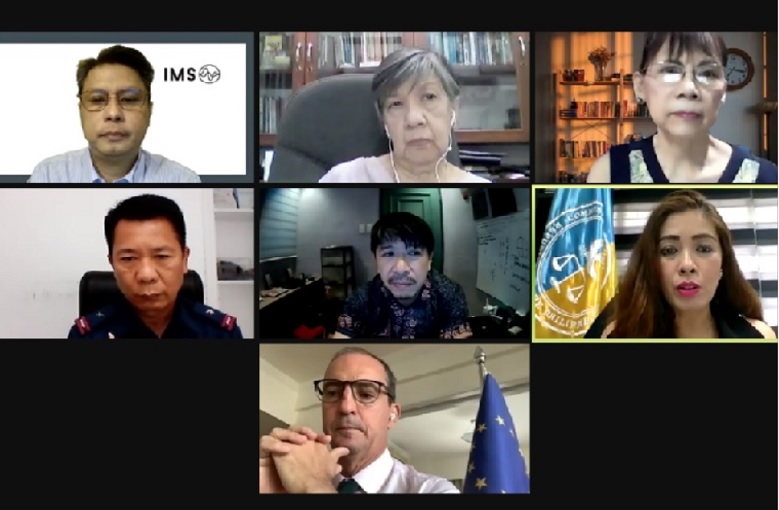The Commission on Human Rights (CHR) said it is boosting existing safety mechanisms to respond to attacks against journalists and media workers as press freedom in the country continue to decline.
Just last April, the Philippines again moved down two notches in the World Press Freedom Index, ranking 138th out of 180 countries — its fourth consecutive dip in the annual list maintained by Reporters Without Borders (RSF), which considers, among others, the prevailing media environment.
This deteriorating situation highlighted the need for “expedient action,” CHR executive director Jacqueline Ann de Guia said during the launch of the European Union-funded initiative on safeguarding journalists and human rights defenders on May 28.
The project, implemented by the International Media Support (IMS) and Asian Institute for Journalism and Communication (AIJC), is a continuation of the Philippine Plan of Action on the Safety of Journalists (PPASJ). Launched in 2019, the PPASJ contains “action points and recommendations” for the protection of Filipino journalists and media workers.

CHR executive director Jacqueline Ann de Guia gives her keynote address at the launching of IMS and AIJC’s “Safeguarding Journalists and Human Rights Defenders in the Philippines 2021-2022” project, supported by the European Union on May 28. Upper left to bottom: Roby Alampay (IMS Philippine program manager), Quintos-de Jesus, Ann Lourdes Lopez (AIJC senior director for Research, Policy, and Advocacy), PBGen. Vincent Calanoga (Philippine National Police Human Rights Affairs Office chief), Ellecer Carlos (Philippine Alliance of Human Rights Advocates secretary-general), De Guia, and Rafael de Bustamante (deputy head of the Political, Press and Information Section of the EU delegation to the Philippines).
In her keynote address, De Guia said the RSF data “mirrors the realities on the ground,” noting that journalists, media workers, and media organizations are “repeatedly confronted by a dangerous and hostile climate marked by episodes of harassment, silencing, and even death.”
Thus, she encouraged those who have experienced harassment to reach out to the CHR’s help desks and hotlines in its central and regional offices. She also said the commission has aimed to make itself “more accessible” by “strengthening” its social media presence, “especially during the COVID-19 pandemic.”
On the matter of media-related killings, De Guia noted that the CHR, in 2018, established a task force, with the regional offices in Bicol (Luzon), Cebu (Visayas), and Cotabato (Mindanao) serving as “focal points,” that would “monitor and investigate attacks against the free press.”
Through this mechanism, she said the commission has docketed 21 media killings, as well as seven cases involving 20 victims of other alleged human rights violations — including unlawful arrests, frustrated killings, and red-tagging — as of May 2021, all the way from July 2016.
Based on the latest count of the Center for Media Freedom and Responsibility (CMFR), which regularly monitors attacks against press freedom in the Philippines, at least 171 journalists and media workers have been killed in the line of duty since 1986, CMFR executive director Melinda Quintos-de Jesus said in the same forum.
Under the Duterte administration, 19 have been killed, while 204 faced other threats and attacks as of April 30, according to CMFR data. (See Press freedom ‘depends on the people’ – CMFR director)
De Guia said the creation of the CHR task force “only indicates the level of importance that we have given the role of the media, as well as the safety of practitioners, so that free and responsible press can go on unhampered.”
She clarified, however, that these initiatives are only the beginning of an “ongoing effort” to create a dedicated unit and mechanism on media safety within the commission.
But some media advocates expressed doubts over a mechanism that is, essentially, “still a work in progress.”
Less gov’t bureaucracy, more aid
During the open forum segment of the virtual launch, Quintos-de Jesus cautioned against a mechanism that would “again” be riddled with government bureaucracy.
“Again and again [we’ve come up against this],” she said. “Once [the] government works, it (the process) falls into this maze,” to a point that it becomes “easier” for the victim to “call international groups who are ready and will say, ‘what do you need [us] to do?’.”
“This is the kind of response that will make a difference … Unless there is this commitment to a clear process — who do I call 24/7, what kind of response can be provided — otherwise, we’re still [on] the same boat,” she added.
Jonathan de Santos, chairperson of the National Union of Journalists of the Philippines (NUJP), for his part, said the CHR could go beyond existing measures by creating a “mechanism to support or aid” journalists who wish to file a case or seek accountability for attacks they have experienced.
“As I understand it now, [the] CHR can investigate and then they will give a recommendation. And then … the system ends there. I’m not sure [what happens] if a case moves forward, whether the assistance will keep going,” he said.
‘Concrete results’
Addressing these concerns, De Guia reiterated the CHR’s commitment to be more accessible to the media and the general public, whether through its help desks, hotlines, or social media pages.
“To the best of our ability, though overwhelmed with too many cases, we really try to respond to all of those cases,” she said, adding that her office also conducts its own daily monitoring of news reports and information on social media for cases concerning media safety.
De Guia also gave her “personal commitment” as head of the task force on media-related killings that there will be “concrete results,” and assured the public that the current push to further media safety will be sustained even after CHR chair Chito Gascon ends his term in 2022.
“The mandate … of the CHR will remain. We are committed, I am personally committed. I will rally the institution,” De Guia said.